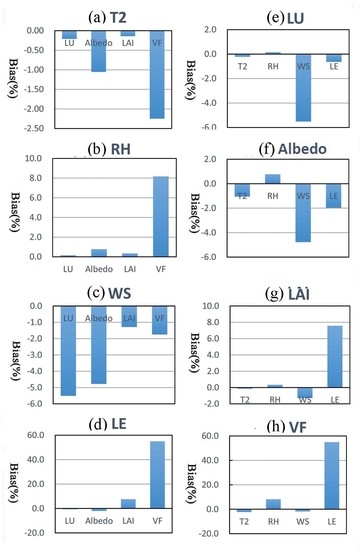Improved Atmospheric Modelling of the Oasis-Desert System in Central Asia Using WRF with Actual Satellite Products
Abstract
:1. Introduction
2. Materials and Methods
2.1. Study Area
2.2. Datasets
2.2.1. Forcing Data and In Situ Measurements
2.2.2. LU
2.2.3. Albedo Product (MCD43A4)
2.2.4. LAI Product (MYD15A2)
2.2.5. VF Data from MODIS Vegetation Indices (VI) (MOD13A2)
2.3. Model Configuration and Experimental Design
3. Results
3.1. Differences between Actual Terrestrial Datasets and the Default Datasets
3.2. Validation and Impacts of Actual LU, Albedo, LAI, and VF Data on Atmospheric Modelling
3.2.1. Radiation and Surface Energy Fluxes
3.2.2. Air Temperature, Humidity at 2 m
3.2.3. Surface Circulation
3.2.4. Impacts of Using Actual Datasets on Atmospheric Modelling
4. Discussion
5. Conclusions
Supplementary Materials
Acknowledgments
Author Contributions
Conflicts of Interest
Abbreviations
| AVHRR | Advanced Very High Resolution Radiometer |
| BRDF | Bidirectional reflectance distribution function |
| CA | Central Asia |
| LAI | Leaf area index |
| LE | Latent heat flux |
| LU | Land use |
| MBE | Mean bias error |
| MM5 | Fifth-generation Penn State/NCAR Mesoscale Model |
| MODIS | MODerate Resolution Imaging Spectroradiometer |
| NCAR | National Center for Atmospheric Research |
| NCEP | National Centers for Environmental Prediction |
| NTM | North Tianshan Mountains |
| OBC | Oasis breeze circulation |
| Q2 | Specific humidity at 2 m |
| R2 | Coefficient of determination |
| RMSE | Root mean squared error |
| RH | 2-m relative humidity |
| RCMs | Regional climate models |
| T2 | 2-m air temperature |
| TIL | Temperature inversion layer |
| USGS | U.S. Geological Survey |
| VF | Vegetation fraction |
| WRF | Weather Research and Forecasting model |
| WS | Wind speed |
| WD | Wind direction |
References
- Hu, Z.; Zhang, C.; Hu, Q.; Tian, H. Temperature changes in central asia from 1979 to 2011 based on multiple datasets. J. Clim. 2014, 27, 1143–1167. [Google Scholar] [CrossRef]
- Li, C.F.; Zhang, C.; Luo, G.P.; Chen, X.; Maisupova, B.; Madaminov, A.A.; Han, Q.F.; Djenbaev, B.M. Carbon stock and its responses to climate change in central Asia. Glob. Chang. Biol. 2015, 21, 1951–1967. [Google Scholar] [CrossRef] [PubMed]
- Zhang, B.; Tan, Y.; Mo, K.G. Digital spectrum and analysis of altitudinal belts in the tianshan mountains. Mt. Res. 2004, 22, 8. [Google Scholar]
- Gessner, U.; Naeimi, V.; Klein, I.; Kuenzer, C.; Klein, D.; Dech, S. The relationship between precipitation anomalies and satellite-derived vegetation activity in central Asia. Glob. Planet. Chang. 2013, 110, 74–87. [Google Scholar] [CrossRef]
- Immerzeel, W.W.; Van Beek, L.P.; Bierkens, M.F. Climate change will affect the asian water towers. Science 2010, 328, 1382–1385. [Google Scholar] [CrossRef] [PubMed]
- Luo, G.P.; Feng, Y.X.; Zhang, B.P.; Cheng, W.M. Sustainable land-use patterns for arid lands: A case study in the northern slope areas of the Tianshan Mountains. J. Geogr. Sci. 2010, 20, 510–524. [Google Scholar] [CrossRef]
- Bothe, O.; Fraedrich, K.; Zhu, X.H. Precipitation climate of central asia and the large-scale atmospheric circulation. Theor. Appl. Climatol. 2012, 108, 345–354. [Google Scholar] [CrossRef]
- Deng, M.J. Current situation and its potential analysis of exploration and utilization of groundwater resources of Xinjiang. Arid Land Geogr. 2009, 32, 647–654. [Google Scholar]
- Souza, V.; Espinosa-Asuar, L.; Escalante, A.E.; Eguiarte, L.E.; Farmer, J.; Forney, L.; Lloret, L.; Rodríguez-Martínez, J.M.; Soberón, X.; Dirzo, R. An endangered oasis of aquatic microbial biodiversity in the chihuahuan desert. Proc. Natl. Acad. Sci. USA 2006, 103, 6565–6570. [Google Scholar] [CrossRef] [PubMed]
- Smith, J.R.; Hawkins, A.L.; Asmerom, Y.; Polyak, V.; Giegengack, R. New age constraints on the middle stone age occupations of kharga oasis, Western Desert, Egypt. J. Hum. Evol. 2007, 52, 690–701. [Google Scholar] [CrossRef] [PubMed]
- Soltan, M. Evaluation of ground water quality in dakhla oasis (Egyptian Western Desert). Environ. Monit. Assess. 1999, 57, 157–168. [Google Scholar] [CrossRef]
- Li, J.; Zhao, C.; Zhu, H.; Li, Y.; Wang, F. Effect of plant species on shrub fertile island at an oasis–desert ecotone in the south junggar basin, China. J. Arid Environ. 2007, 71, 350–361. [Google Scholar] [CrossRef]
- Liu, S.H.; Liu, H.P.; Hu, Y.; Zhang, C.; Liang, F.; Wang, J. Numerical simulations of land surface physical processes and land-atmosphere interactions over oasis-desert/gobi region. Sci. China Ser. D Earth Sci. 2007, 50, 290–295. [Google Scholar] [CrossRef]
- Meng, X.H.; Lü, S.H.; Zhang, T.T.; Guo, J.X.; Gao, Y.H.; Bao, Y.; Wen, L.J.; Luo, S.Q.; Liu, Y.P. Numerical simulations of the atmospheric and land conditions over the jinta oasis in northwestern China with satellite-derived land surface parameters. Int. J. Climatol. 2009, 114. [Google Scholar] [CrossRef]
- Sorg, A.; Bolch, T.; Stoffel, M.; Solomina, O.; Beniston, M. Climate change impacts on glaciers and runoff in tien shan (central Asia). Nat. Clim. Chang. 2012, 2, 725–731. [Google Scholar] [CrossRef]
- He, Q.; Yang, Q.; Li, H.-J. Variations of air temperature, precipitation and sand-dust weather in Xinjiang in past 40 years. J. Glaciol. Geocryol. 2003, 25, 423–427. [Google Scholar]
- Xu, G.-Q.; Wei, W.-S. Climate change of Xinjiang and its impact on eco-enviroment. Arid Land Geogr. 2004, 1, 14–27. [Google Scholar]
- Lianmei, Y. Climate change of extreme precipitation in Xinjiang. Acta Geogr. Sin. 2003, 58, 577–583. [Google Scholar]
- Lioubimtseva, E.; Henebry, G.M. Climate and environmental change in arid central asia: Impacts, vulnerability, and adaptations. J. Arid Environ. 2009, 73, 963–977. [Google Scholar] [CrossRef]
- Zhang, H.; Wu, J.-W.; Zheng, Q.-H.; Yu, Y.-J. A preliminary study of oasis evolution in the tarim basin, Xinjiang, China. J. Arid Environ. 2003, 55, 545–553. [Google Scholar]
- Zhang, Q.; Luo, G.; Li, L.; Zhang, M.; Lv, N.; Wang, X. An analysis of oasis evolution based on land use and land cover change: A case study in the sangong river basin on the northern slope of the Tianshan Mountains. J. Geogr. Sci. 2017, 27, 223–239. [Google Scholar] [CrossRef]
- Jia, B.; Zhang, Z.; Ci, L.; Ren, Y.; Pan, B.; Zhang, Z. Oasis land-use dynamics and its influence on the oasis environment in Xinjiang, China. J. Arid Environ. 2004, 56, 11–26. [Google Scholar] [CrossRef]
- Sun, D.; Zhao, C.; Wei, H.; Peng, D. Simulation of the relationship between land use and groundwater level in tailan river basin, Xinjiang, China. Quat. Int. 2011, 244, 254–263. [Google Scholar] [CrossRef]
- Wang, Y.; Xiao, D.; Li, Y.; Li, X. Soil salinity evolution and its relationship with dynamics of groundwater in the oasis of inland river basins: Case study from the fubei region of Xinjiang Province, China. Environ. Monit. Assess. 2008, 140, 291–302. [Google Scholar] [CrossRef] [PubMed]
- Lioubimtseva, E.; Cole, R.; Adams, J.M.; Kapustin, G. Impacts of climate and land-cover changes in arid lands of central Asia. J. Arid Environ. 2005, 62, 285–308. [Google Scholar] [CrossRef]
- Yao, Y.H.; Zhang, B.P. A preliminary study of the heating effect of the Tibetan Plateau. PLoS ONE 2013, 8. [Google Scholar] [CrossRef] [PubMed]
- Zhou, Y.; Zhang, L.; Fensholt, R.; Wang, K.; Vitkovskaya, I.; Tian, F. Climate contributions to vegetation variations in central asian drylands: Pre-and post-ussr collapse. Remote Sens. 2015, 7, 2449–2470. [Google Scholar] [CrossRef]
- Horton, D.E.; Johnson, N.C.; Singh, D.; Swain, D.L.; Rajaratnam, B.; Diffenbaugh, N.S. Contribution of changes in atmospheric circulation patterns to extreme temperature trends. Nature 2015, 522, 465–469. [Google Scholar] [CrossRef] [PubMed]
- Qu, R.; Cui, X.; Yan, H.; Ma, E.; Zhan, J. Impacts of land cover change on the near-surface temperature in the North China plain. Adv. Meteorol. 2013, 2013, 153–156. [Google Scholar] [CrossRef]
- Yan, J.W.; Liu, J.Y.; Chen, B.Z.; Feng, M.; Fang, S.F.; Xu, G.; Zhang, H.F.; Che, M.L.; Liang, W.; Hu, Y.F. Changes in the land surface energy budget in eastern China over the past three decades: Contributions of land-cover change and climate change. J. Clim. 2014, 27, 9233–9252. [Google Scholar] [CrossRef]
- Yu, G.R.; Wen, X.F.; Sun, X.M.; Tanner, B.D.; Lee, X.H.; Chen, J.Y. Overview of chinaflux and evaluation of its eddy covariance measurement. Agric. For. Meteorol. 2006, 137, 125–137. [Google Scholar] [CrossRef]
- Li, X.; Cheng, G.D.; Liu, S.M.; Xiao, Q.; Ma, M.G.; Jin, R.; Che, T.; Liu, Q.H.; Wang, W.Z.; Qi, Y. Heihe watershed allied telemetry experimental research (hiwater): Scientific objectives and experimental design. Bull. Am. Meteor. Soc. 2013, 94, 1145–1160. [Google Scholar] [CrossRef]
- Seungbum, H.; Lakshmi, V.; Small, E.E.; Chen, F.; Tewari, M.; Manning, K.W. Effects of vegetation and soil moisture on the simulated land surface processes from the coupled WRF/Noah model. Int. J. Climatol. 2009, 114. [Google Scholar] [CrossRef]
- Seneviratne, S.I.; Lüthi, D.; Litschi, M.; Schär, C. Land–atmosphere coupling and climate change in Europe. Nature 2006, 443, 205–209. [Google Scholar] [CrossRef] [PubMed]
- Kyselý, J.; Rulfová, Z.; Farda, A.; Hanel, M. Convective and stratiform precipitation characteristics in an ensemble of regional climate model simulations. Clim. Dyn. 2016, 46, 227–243. [Google Scholar] [CrossRef]
- Branch, O.; Warrach-Sagi, K.; Wulfmeyer, V.; Cohen, S. Simulation of semi-arid biomass plantations and irrigation using the WRF-Noah model—A comparison with observations from israel. Hydrol. Earth Syst. Sci. 2014, 18, 1761–1783. [Google Scholar] [CrossRef]
- Cao, Q.; Yu, D.Y.; Georgescu, M.; Han, Z.; Wu, J.G. Impacts of land use and land cover change on regional climate: A case study in the agro-pastoral transitional zone of China. Environ. Res. Lett. 2015, 10. [Google Scholar] [CrossRef]
- Lenderink, G.; Van Ulden, A.; Van den Hurk, B.; Van Meijgaard, E. Summertime inter-annual temperature variability in an ensemble of regional model simulations: Analysis of the surface energy budget. Clim. Chang. 2007, 81, 233–247. [Google Scholar] [CrossRef]
- Vidale, P.L.; Lüthi, D.; Wegmann, R.; Schär, C. European summer climate variability in a heterogeneous multi-model ensemble. Clim. Chang. 2007, 81, 209–232. [Google Scholar] [CrossRef]
- Deng, X.Z.; Shi, Q.L.; Zhang, Q.; Shi, C.C.; Yin, F. Impacts of land use and land cover changes on surface energy and water balance in the Heihe River basin of China, 2000–2010. Phys. Chem. Earth Parts A/B/C 2015, 79–82, 2–10. [Google Scholar] [CrossRef]
- Yin, J.F.; Zhan, X.W.; Zheng, Y.F.; Hain, C.R.; Ek, M.; Wen, J.; Fang, L.; Liu, J.C. Improving noah land surface model performance using near real time surface albedo and green vegetation fraction. Agric. For. Meteorol. 2016, 218, 171–183. [Google Scholar] [CrossRef]
- Wen, X.H.; Lu, S.H.; Jin, J.M. Integrating remote sensing data with WRF for improved simulations of oasis effects on local weather processes over an arid region in Northwestern China. J. Hydrol. 2012, 13, 573–587. [Google Scholar] [CrossRef]
- Xu, Z.F.; Mahmood, R.; Yang, Z.L.; Fu, C.; Su, H. Investigating diurnal and seasonal climatic response to land use and land cover change over monsoon Asia with the community earth system model. Int. J. Climatol. 2015, 120, 1137–1152. [Google Scholar] [CrossRef]
- Qiu, Y.; Hu, Q.; Zhang, C. WRF simulation and downscaling of local climate in central Asia. Int. J. Climatol. 2017, 37, 513–528. [Google Scholar] [CrossRef]
- Dee, D.P.; Uppala, S.M.; Simmons, A.J.; Berrisford, P.; Poli, P.; Kobayashi, S.; Andrae, U.; Balmaseda, M.A.; Balsamo, G.; Bauer, P. The era-interim reanalysis: Configuration and performance of the data assimilation system. Q. J. R. Meteorol. Soc. 2011, 137, 553–597. [Google Scholar] [CrossRef]
- Chen, X.B. Land Use/Cover Change in Arid Area in China, 1st ed.; China Science Publishing & Media Ltd.: Beijing, China, 2008; pp. 55–124. ISBN 9787030200372. [Google Scholar]
- Cescatti, A.; Marcolla, B.; Vannan, S.K.S.; Pan, J.Y.; Román, M.O.; Yang, X.; Ciais, P.; Cook, R.B.; Law, B.E.; Matteucci, G. Intercomparison of modis albedo retrievals and in situ measurements across the global fluxnet network. Remote Sens. Environ. 2012, 121, 323–334. [Google Scholar] [CrossRef]
- Stroeve, J.; Box, J.E.; Wang, Z.; Schaaf, C.; Barrett, A. Re-evaluation of modis MCD43 greenland albedo accuracy and trends. Remote Sens. Environ. 2013, 138, 199–214. [Google Scholar] [CrossRef]
- Román, M.O.; Gatebe, C.K.; Shuai, Y.; Wang, Z.; Gao, F.; Masek, J.G.; He, T.; Liang, S.; Schaaf, C.B. Use of in situ and airborne multiangle data to assess modis-and landsat-based estimates of directional reflectance and albedo. IEEE Trans. Geosci. Remote Sens. 2013, 51, 1393–1404. [Google Scholar] [CrossRef]
- Yan, K.; Park, T.; Yan, G.; Chen, C.; Yang, B.; Liu, Z.; Nemani, R.R.; Knyazikhin, Y.; Myneni, R.B. Evaluation of modis lai/fpar product collection 6. Part 1: Consistency and improvements. Remote Sens. 2016, 8, 359. [Google Scholar] [CrossRef]
- Yan, K.; Park, T.; Yan, G.j.; Liu, Z.; Yang, B.; Chen, C.; Nemani, R.R.; Knyazikhin, Y.; Myneni, R.B. Evaluation of MODIS LAI/FPAR product collection 6. Part 2: Validation and intercomparison. Remote Sens. 2016, 8, 460. [Google Scholar] [CrossRef]
- Fensholt, R.; Sandholt, I.; Rasmussen, M.S. Evaluation of modis lai, fapar and the relation between fapar and ndvi in a semi-arid environment using in situ measurements. Remote Sens. Environ. 2004, 91, 490–507. [Google Scholar] [CrossRef]
- Sesnie, S.E.; Dickson, B.G.; Rosenstock, S.S.; Rundall, J.M. A comparison of landsat tm and modis vegetation indices for estimating forage phenology in desert bighorn sheep (Ovis canadensis nelsoni) habitat in the sonoran desert, USA. Int. J. Remote Sens. 2012, 33, 276–286. [Google Scholar] [CrossRef]
- Sims, D.A.; Rahman, A.F.; Vermote, E.F.; Jiang, Z. Seasonal and inter-annual variation in view angle effects on modis vegetation indices at three forest sites. Remote Sens. Environ. 2011, 115, 3112–3120. [Google Scholar] [CrossRef]
- Miller, J.; Barlage, M.; Zeng, X.; Wei, H.; Mitchell, K.; Tarpley, D. Sensitivity of the ncep/noah land surface model to the modis green vegetation fraction data set. Geophys. Res. Lett. 2006, 33. [Google Scholar] [CrossRef]
- Zeng, X.B.; Dickinson, R.E.; Walker, A.; Shaikh, M.; DeFries, R.S.; Qi, J. Derivation and evaluation of global 1-km fractional vegetation cover data for land modeling. J. Appl. Meteorol. 2000, 39, 826–839. [Google Scholar] [CrossRef]
- Gutman, G.; Ignatov, A. The derivation of the green vegetation fraction from NOAA/AVHRR data for use in numerical weather prediction models. Int. J. Remote Sens. 1998, 19, 1533–1543. [Google Scholar] [CrossRef]
- Jiang, L.; Kogan, F.N.; Guo, W.; Tarpley, J.D.; Mitchell, K.E.; Ek, M.B.; Tian, Y.; Zheng, W.; Zou, C.Z.; Ramsay, B.H. Real-time weekly global green vegetation fraction derived from advanced very high resolution radiometer-based noaa operational global vegetation index (GVI) system. Int. J. Climatol. 2010, 115. [Google Scholar] [CrossRef]
- Li, X.S.; Zhang, J. Derivation of the green vegetation fraction of the whole China from 2000 to 2010 from modis data. Earth Interact. 2016, 20, 1–16. [Google Scholar] [CrossRef]
- MODIS/Terra Vegetation Indices 16-Day L3 Global 1km Grid SIN V006. Available online: https://lpdaac.usgs.gov/dataset_discovery (accessed on 3 April 2016).
- Song, Y.H.; Noh, Y.; Dudhia, J. A new vertical diffusion package with an explicit treatment of entrainment processes. Mon. Weather Rev. 2006, 134, 2318–2341. [Google Scholar]
- Song, Y.H.; Dudhia, J.; Chen, S.H. A revised approach to ice microphysical processes for the bulk parameterization of clouds and precipitation. Mon. Weather Rev. 2004, 132, 103–120. [Google Scholar]
- Bretherton, C.S.; McCaa, J.R.; Grenier, H. A new parameterization for shallow cumulus convection and its application to marine subtropical cloud-topped boundary layers. Part I: Description and 1D results. Mon. Weather Rev. 2004, 132, 864–882. [Google Scholar] [CrossRef]
- Collins, W.; Rasch, P.; Boville, B.A.; Hack, J.J.; McCaa, J.R.; Williamson, D.L.; Kiehl, J.T.; Briegleb, B.; Bitz, C.; Lin, S.J. Description of the NCAR Community Atmosphere Model (CAM 3.0); Technical Report; National Center for Atmospheric Research: Boulder, CO, USA, 2004. [Google Scholar] [CrossRef]
- Lim, Y.-J.; Hong, J.; Lee, T.-Y. Spin-up behavior of soil moisture content over east asia in a land surface model. Meteor. Atmos. Phys. 2012, 118, 151–161. [Google Scholar] [CrossRef]
- Chu, P.; Liv, S.H.; Chen, Y.C. A numerical modeling study on desert oasis self-supporting mechanisms. J. Hydrol. 2005, 312, 256–276. [Google Scholar] [CrossRef]
- Meng, X.H.; Lu, S.; Zhang, T.; Ao, Y.; Li, S.; Bao, Y.; Wen, L.; Luo, S. Impacts of inhomogeneous landscapes in oasis interior on the oasis self-maintenance mechanism by integrating numerical model with satellite data. Hydrol. Earth Syst. Sci. 2012, 16, 3729–3738. [Google Scholar] [CrossRef] [Green Version]
- Fan, Z.; Wu, S.; Wu, Y.; Zhang, P.; Zhao, X.; Zhang, J. The land reclamation in xinjiang since the founding of new China. J. Nat. Resour. 2013, 28, 713–720. [Google Scholar]
- Zhu, L.; Luo, G.P.; Chen, X.; Xu, W.; Feng, Y.; Zhen, Q.; Wang, J.; Zhou, D.; Yin, C. Detection of land use/land cover change in the middle and lower reaches of the Ili river, 1970–2007. Prog. Geogr. 2010, 29, 292–300. [Google Scholar]
- Zhang, M.; Ma, M.; De Maeyer, P.; Kurban, A. Uncertainties in classification system conversion and an analysis of inconsistencies in global land cover products. ISPRS Int. J. Geo Inf. 2017, 6, 112. [Google Scholar] [CrossRef]
- Kumar, A.; Chen, F.; Barlage, M.; Ek, M.B.; Niyogi, D. Assessing impacts of integrating modis vegetation data in the weather research and forecasting (WRF) model coupled to two different canopy-resistance approaches. J. Appl. Meteorol. 2014, 53, 1362–1380. [Google Scholar] [CrossRef]
- Zhang, C.; Fan, G.; Ma, Z.; Cheng, B.; Zhao, B.; Feng, J.; Wang, H. Characteristics of albedo over different underlying surface in the semi-arid area. Plateau Meteorol. 2015, 34, 1029–1040. [Google Scholar]
- Litan, S.; Shalamu, A.; Yu-dong, S. Effects of drip irrigation volume on soil water-salt transfer and its redistribution. Arid Zone Res. 2011, 1, 79–84. [Google Scholar]
- Zhang, L.; Jiang, P.; Wu, H.; Li, M. Research on spectral characteristics of typical soil in North Xinjiang. J. Soil Water Conserv. 2013, 4, 273–276. [Google Scholar]
- Liu, X.; Tian, C. Study on dynamic and balance of salt for cotton under plastic mulch in South Xinjiang. J. Soil Water Conserv. 2005, 6, 82–85. [Google Scholar]
- Wen, J.; Zhao, X.; Liu, Q.; Tang, Y.; Dou, B. An improved land-surface albedo algorithm with dem in rugged terrain. IEEE Geosci. Remote Sens. Lett. 2014, 11, 883–887. [Google Scholar]
- Wen, J.; Dou, B.; You, D.; Tang, Y.; Xiao, Q.; Liu, Q.; Qinhuo, L. Forward a small-timescale BRDF/Albedo by multisensor combined brdf inversion model. IEEE Trans. Geosci. Remote Sens. 2017, 55, 683–697. [Google Scholar] [CrossRef]
- Wen, J.; Liu, Q.; Tang, Y.; Dou, B.; You, D.; Xiao, Q.; Liu, Q.; Li, X. Modeling land surface reflectance coupled brdf for HJ-1/CCD data of rugged terrain in Heihe River basin, China. IEEE J. Sel. Top. Appl. Earth Obs. Remote Sens. 2015, 8, 1506–1518. [Google Scholar] [CrossRef]
- Wen, J.; Liu, Q.; Liu, Q.; Xiao, Q.; Li, X. Scale effect and scale correction of land-surface albedo in rugged terrain. Int. J. Remote Sens. 2009, 30, 5397–5420. [Google Scholar] [CrossRef]
- Wen, J.; Liu, Q.; Liu, Q.; Xiao, Q.; Li, X. Parametrized brdf for atmospheric and topographic correction and albedo estimation in Jiangxi rugged terrain, China. Int. J. Remote Sens. 2009, 30, 2875–2896. [Google Scholar] [CrossRef]
- Willmott, C.J. Some comments on the evaluation of model performance. Bull. Am. Meteorol. Soc. 1982, 63, 1309–1313. [Google Scholar] [CrossRef]
- Wang, J.; Li, F.; Song, Q.; Li, S. Effects of plastic film mulching on soil temperature and moisture and on yield formation of spring wheat. Ying Yong Sheng Tai Xue Bao 2003, 14, 205–210. [Google Scholar] [PubMed]
- Li, F.-M.; Wang, P.; Wang, J.; Xu, J.-Z. Effects of irrigation before sowing and plastic film mulching on yield and water uptake of spring wheat in semiarid loess plateau of China. Agric. Water Manag. 2004, 67, 77–88. [Google Scholar] [CrossRef]
- Hanna, S.R.; Yang, R.X. Evaluations of mesoscale models’ simulations of near-surface winds, temperature gradients, and mixing depths. J. Appl. Meteorol. 2001, 40, 1095–1104. [Google Scholar] [CrossRef]
- Gao, Y.; Chen, F.; Barlage, M.; Liu, W.; Cheng, G.; Li, X.; Yu, Y.; Ran, Y.; Li, H.; Peng, H. Enhancement of land surface information and its impact on atmospheric modeling in the Heihe River basin, Northwest China. Int. J. Climatol. 2008, 113. [Google Scholar] [CrossRef]
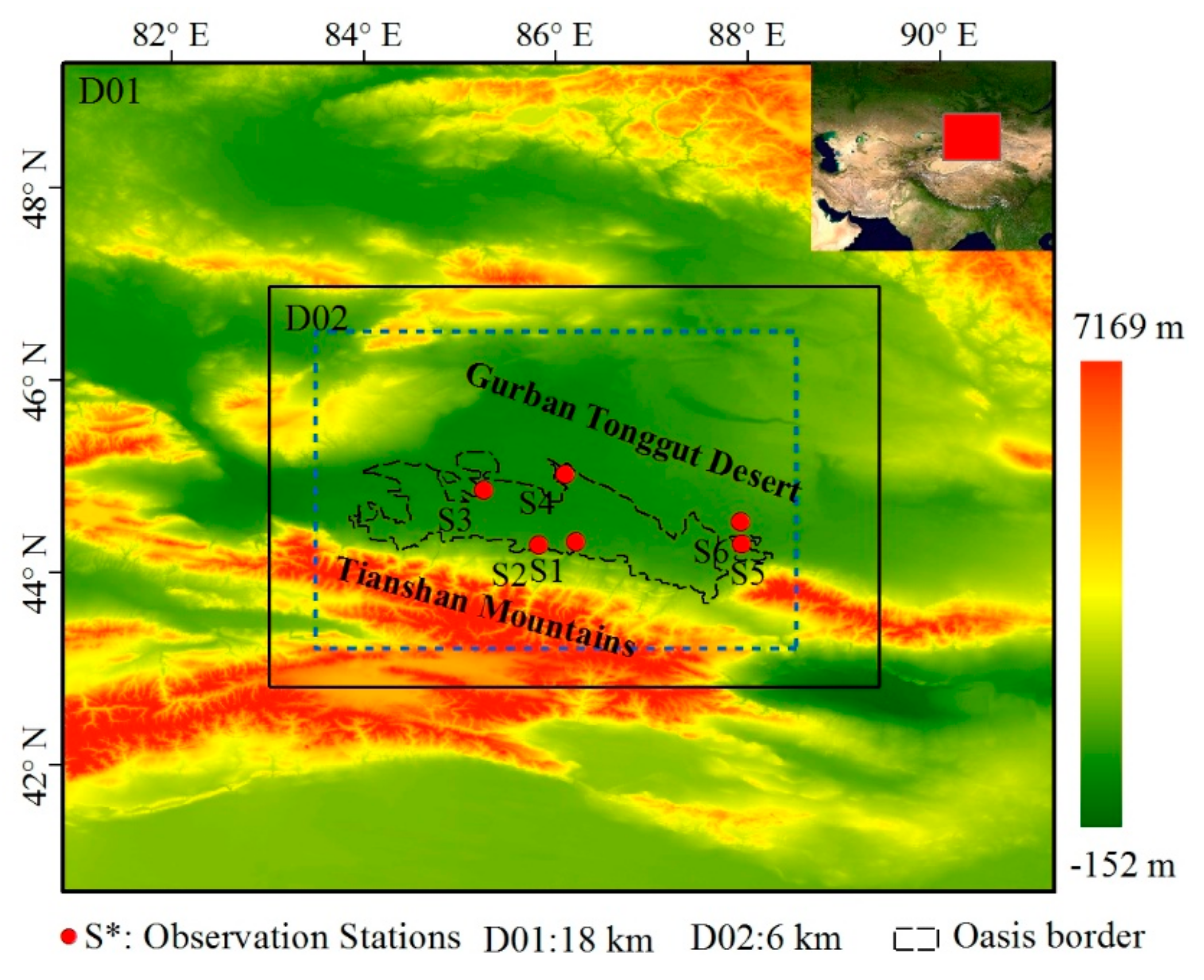

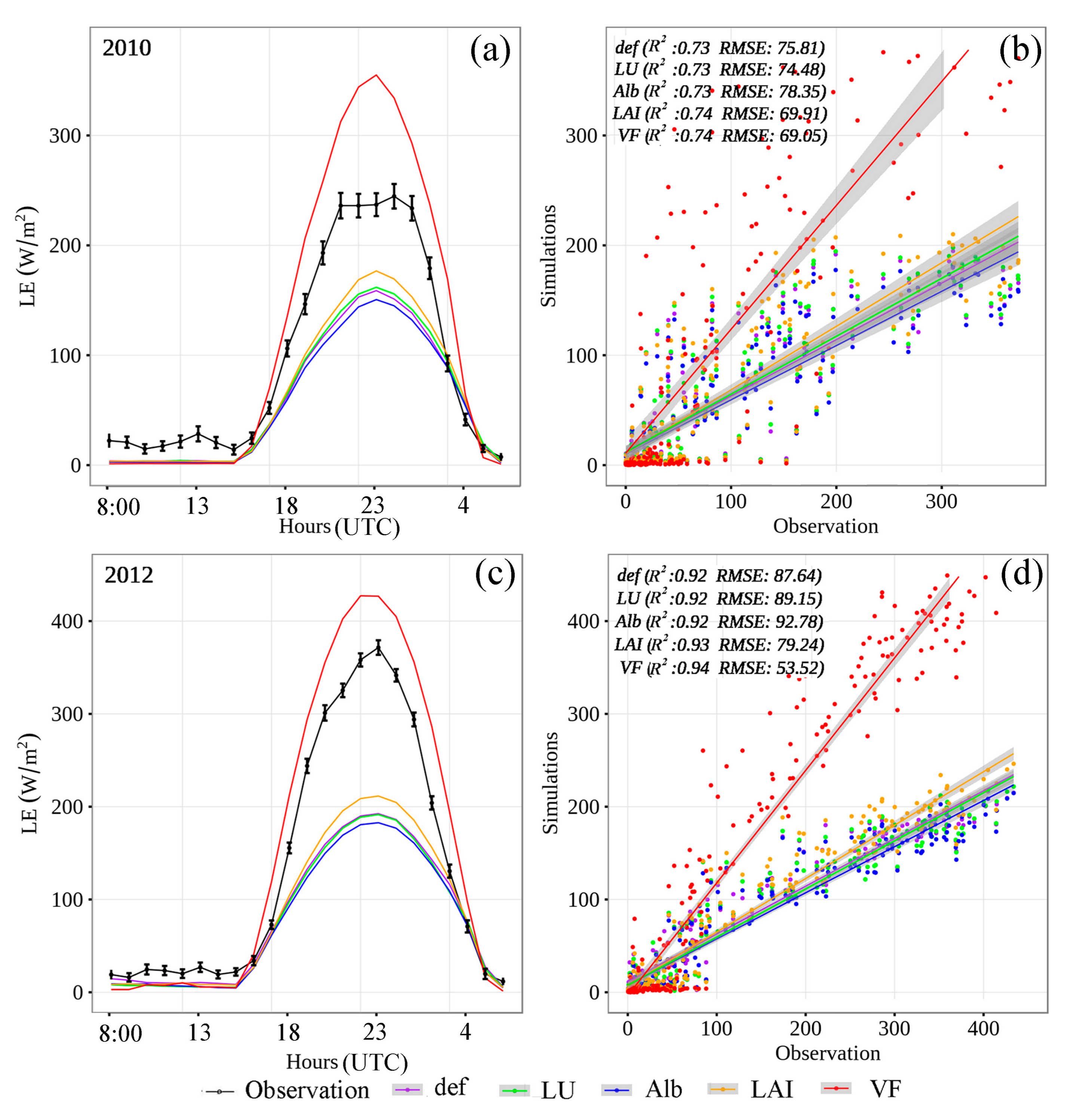
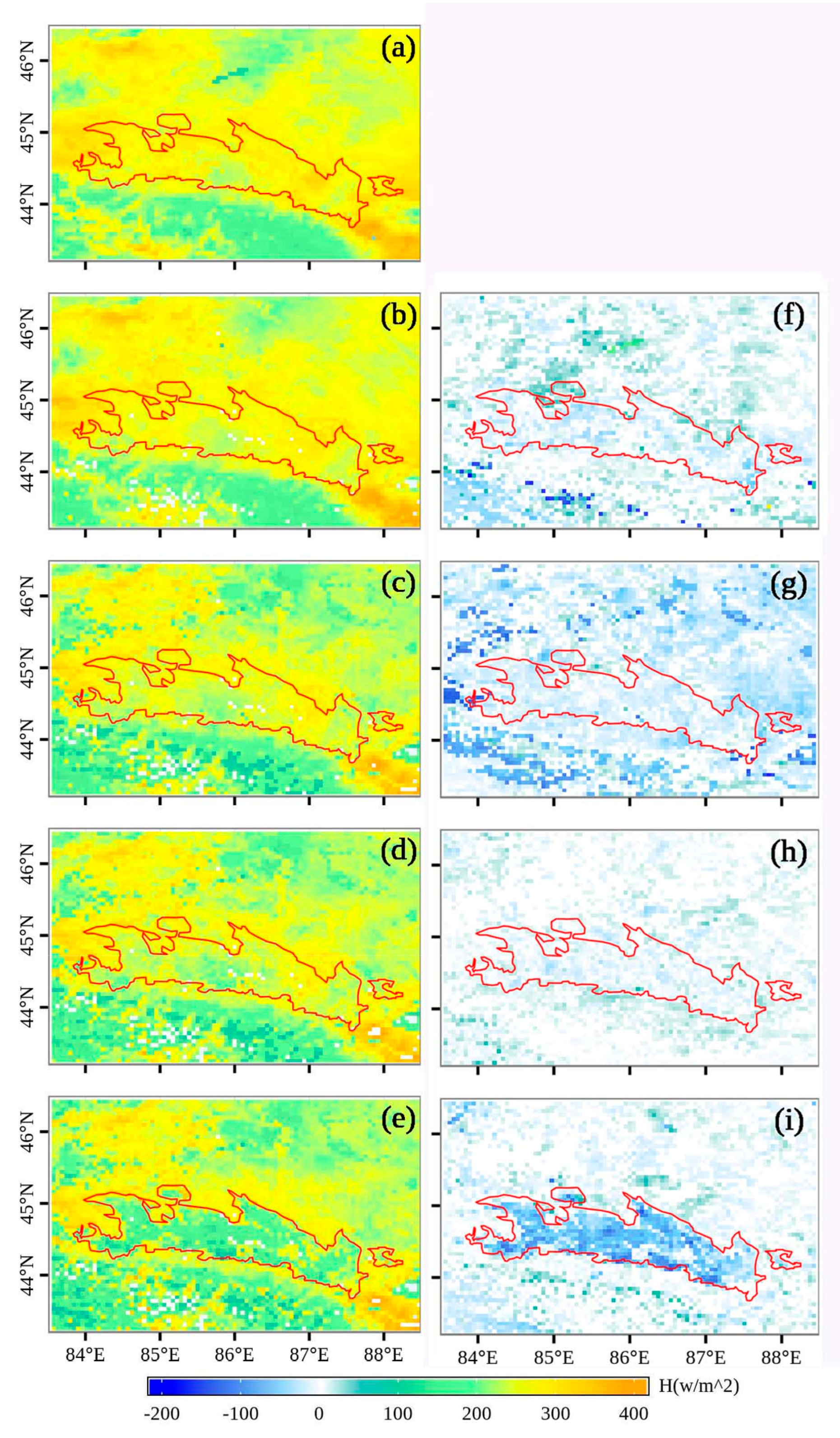
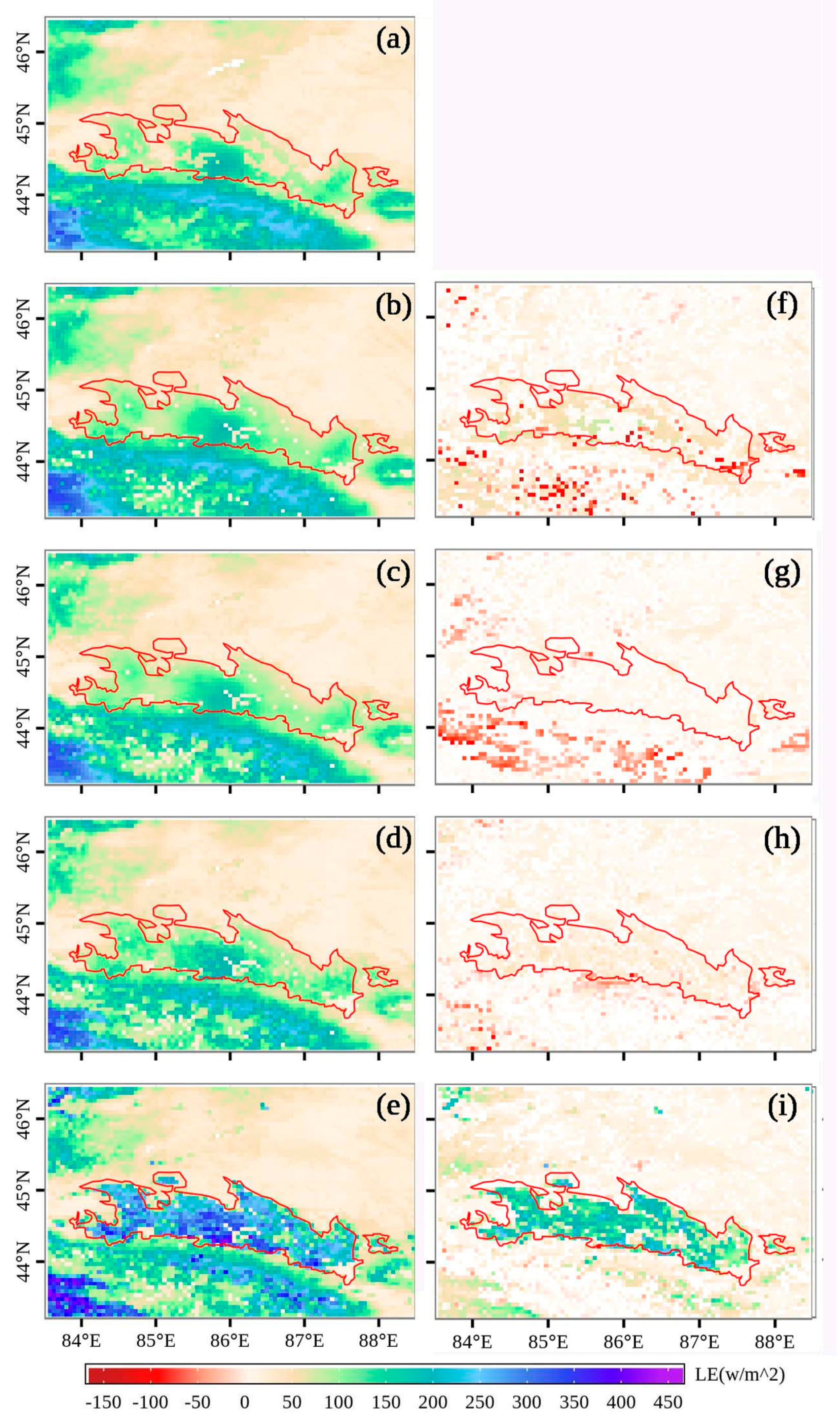
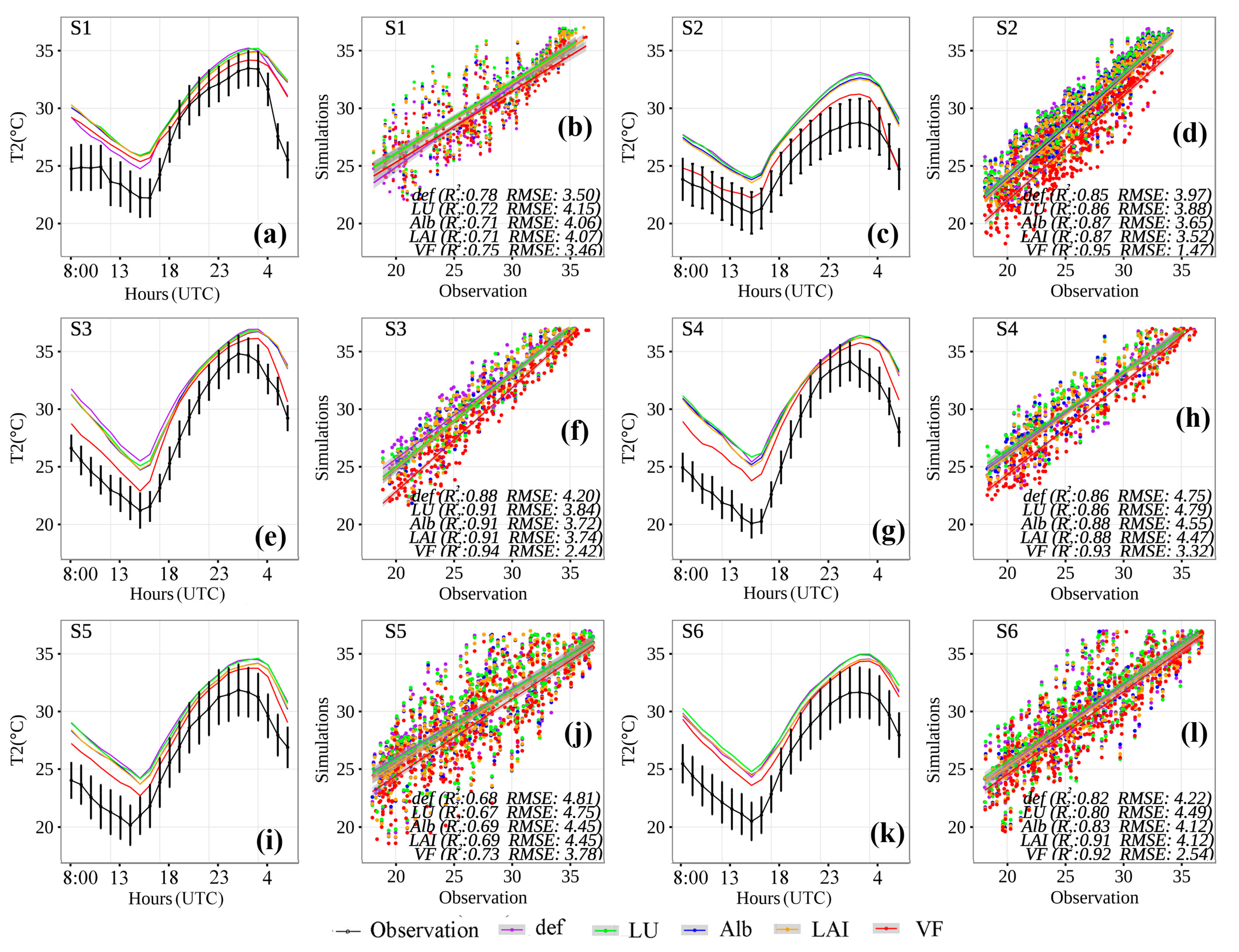
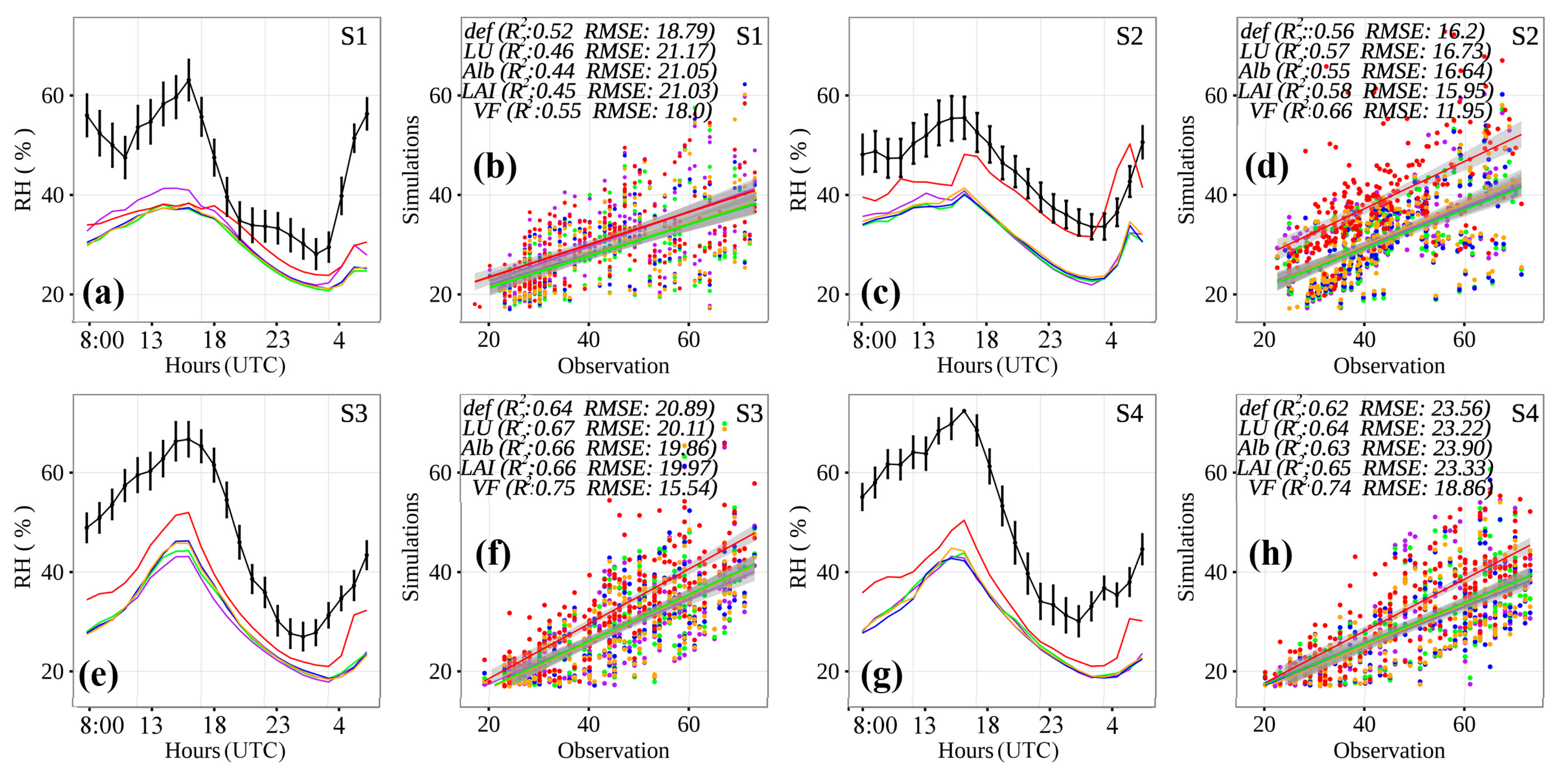

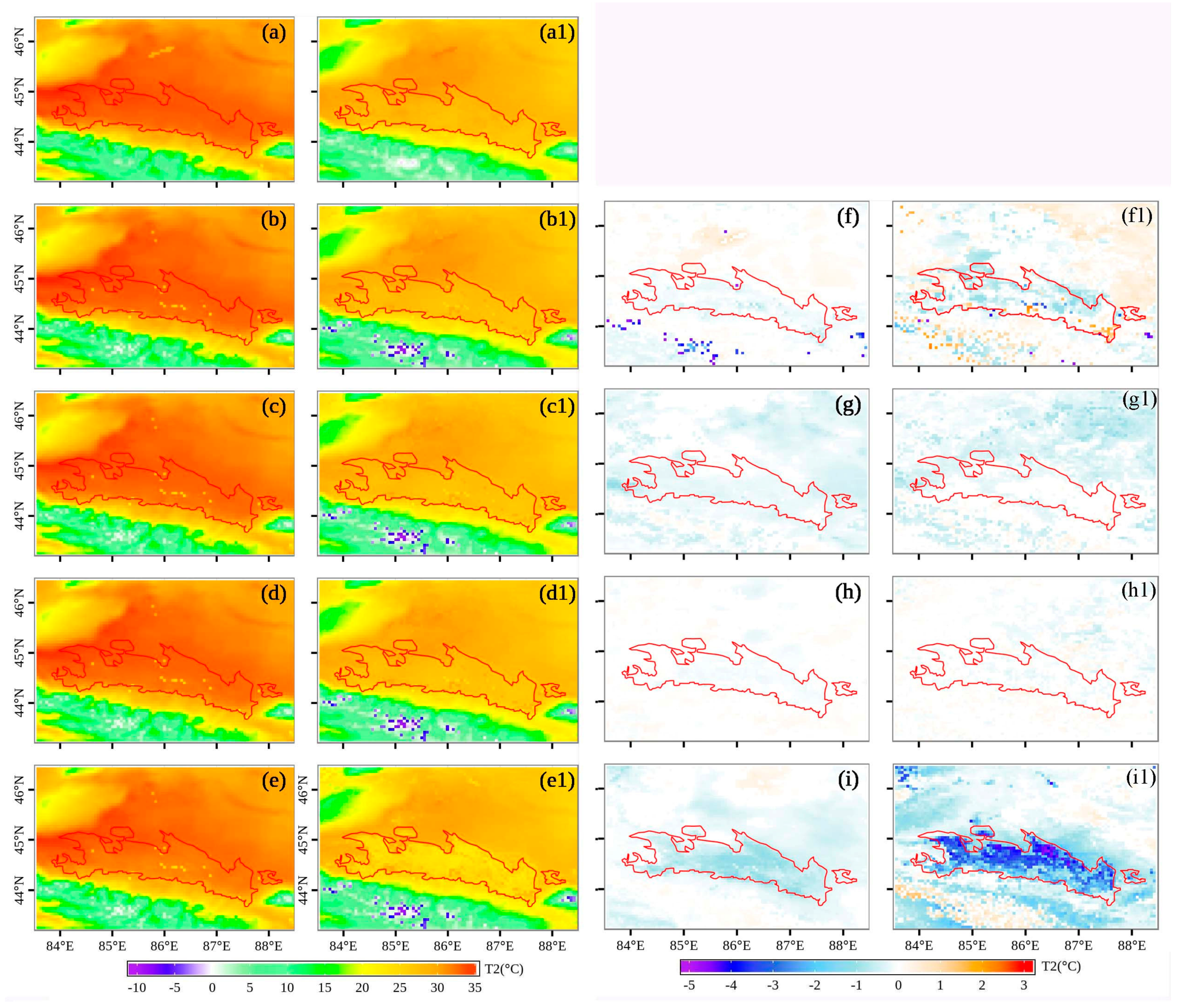
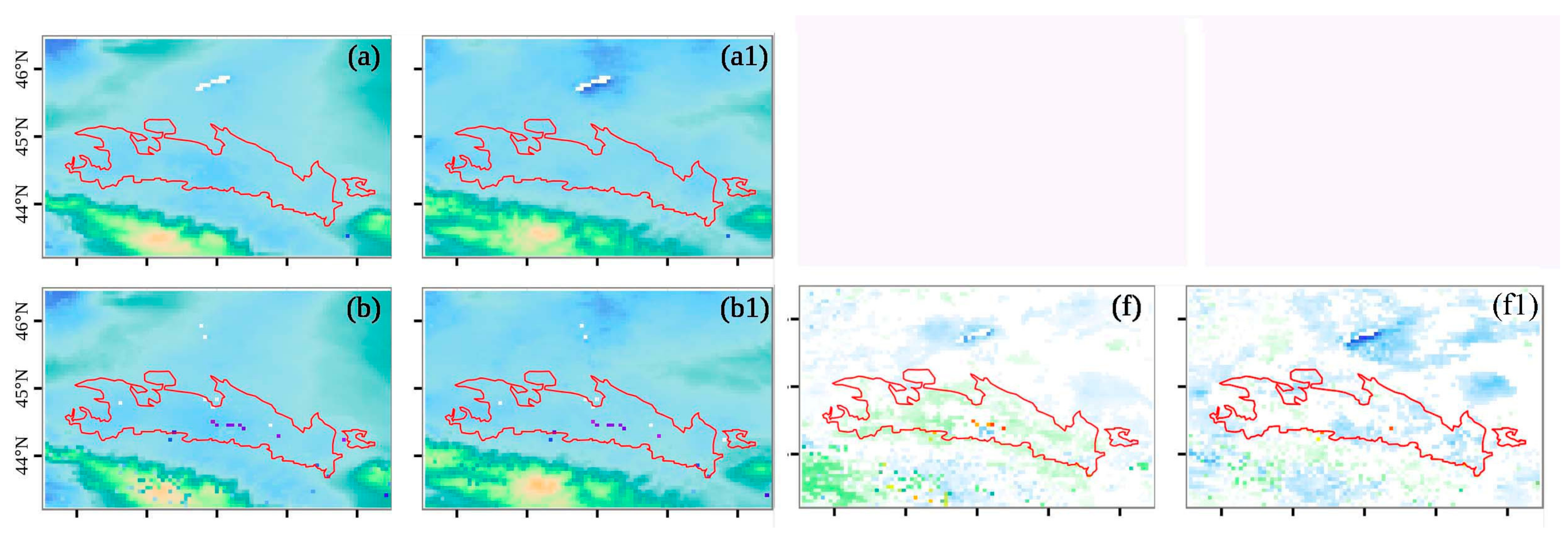
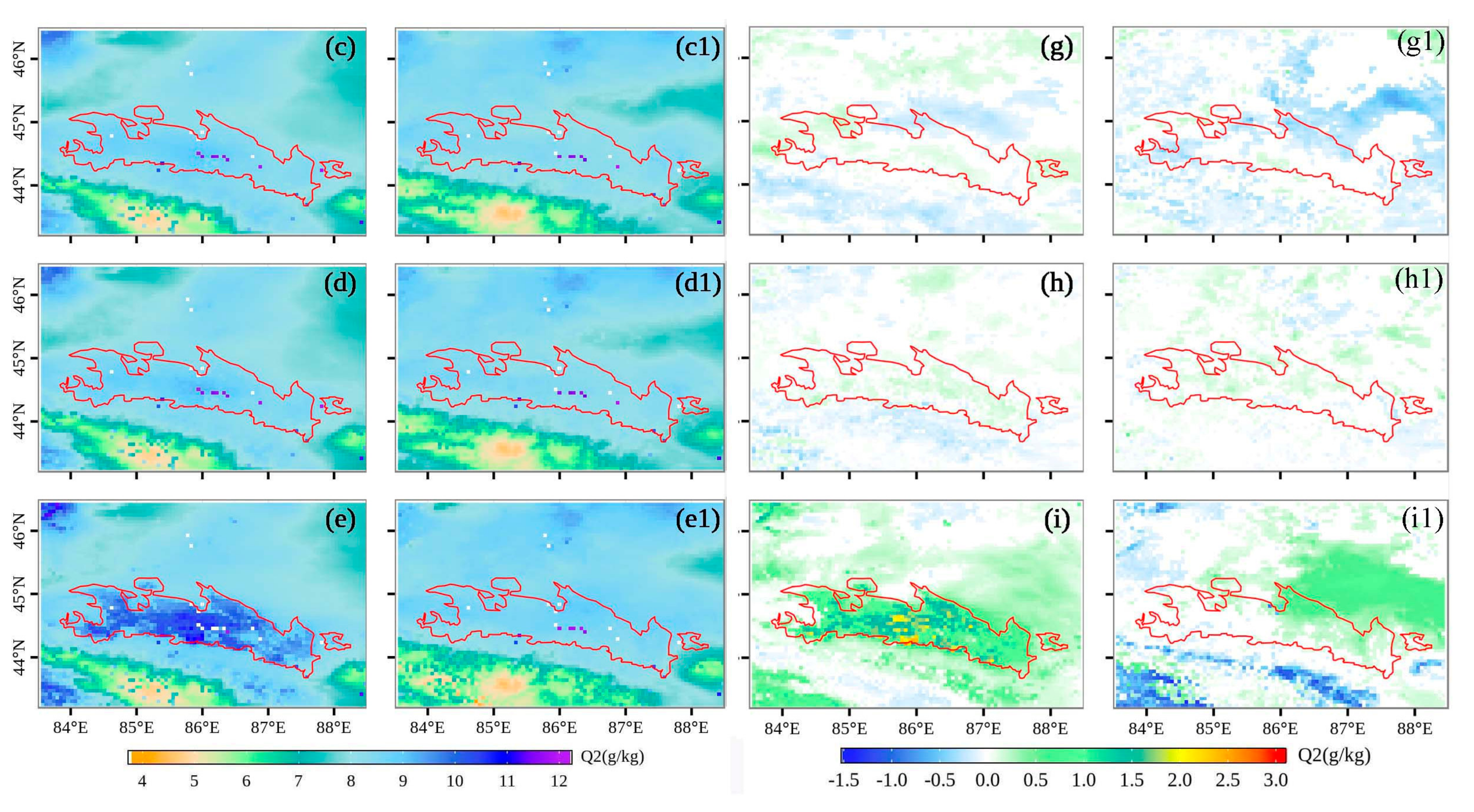
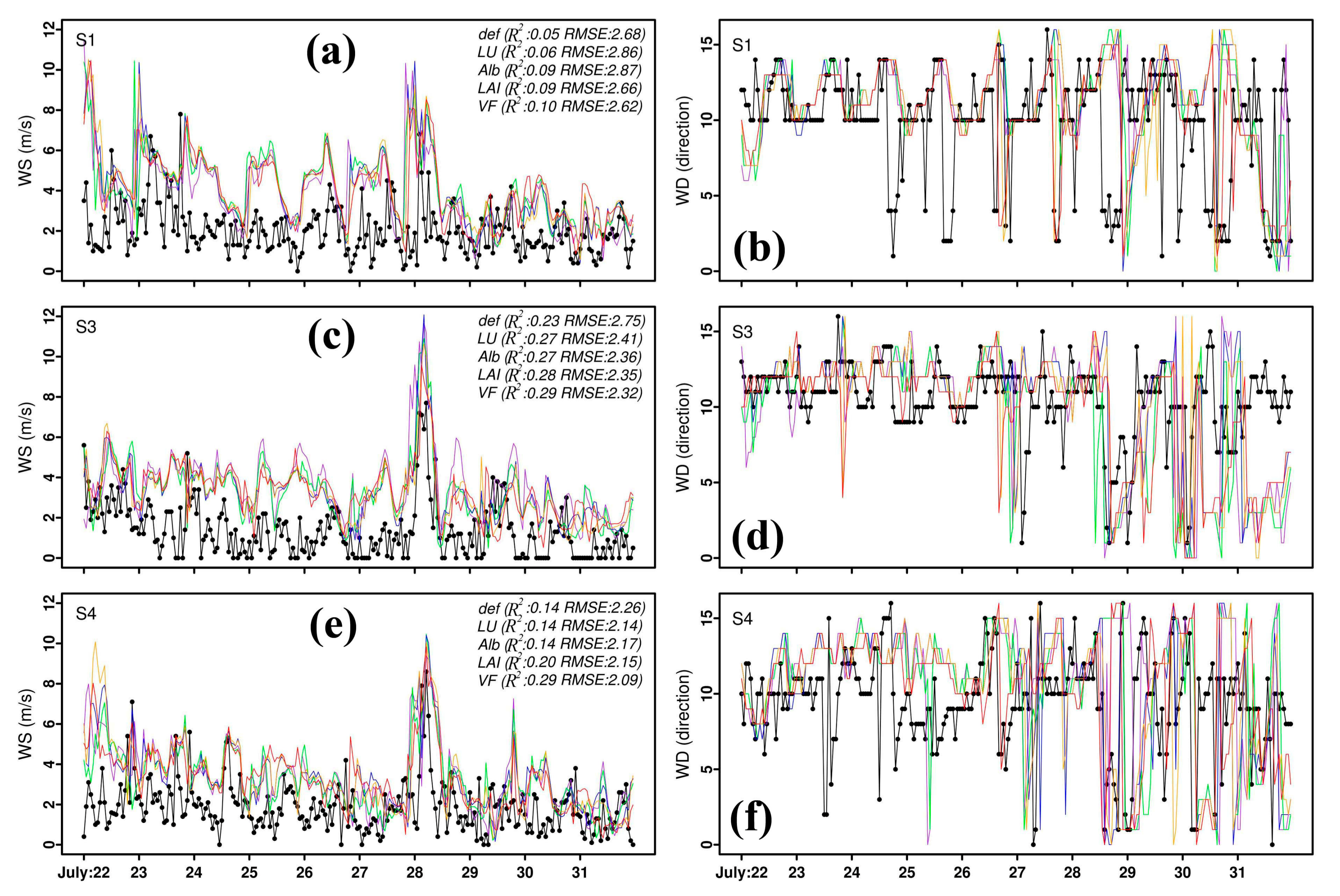
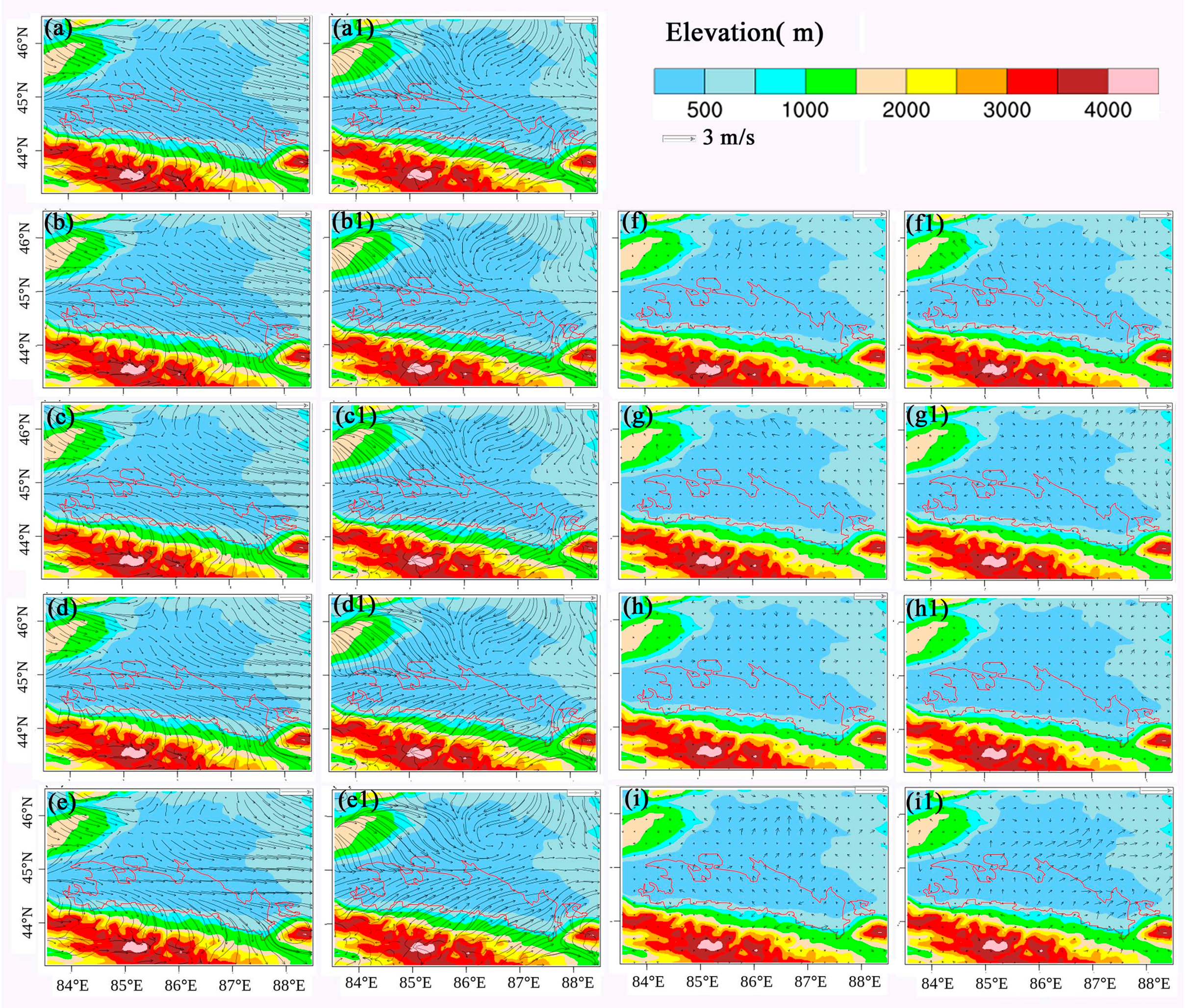
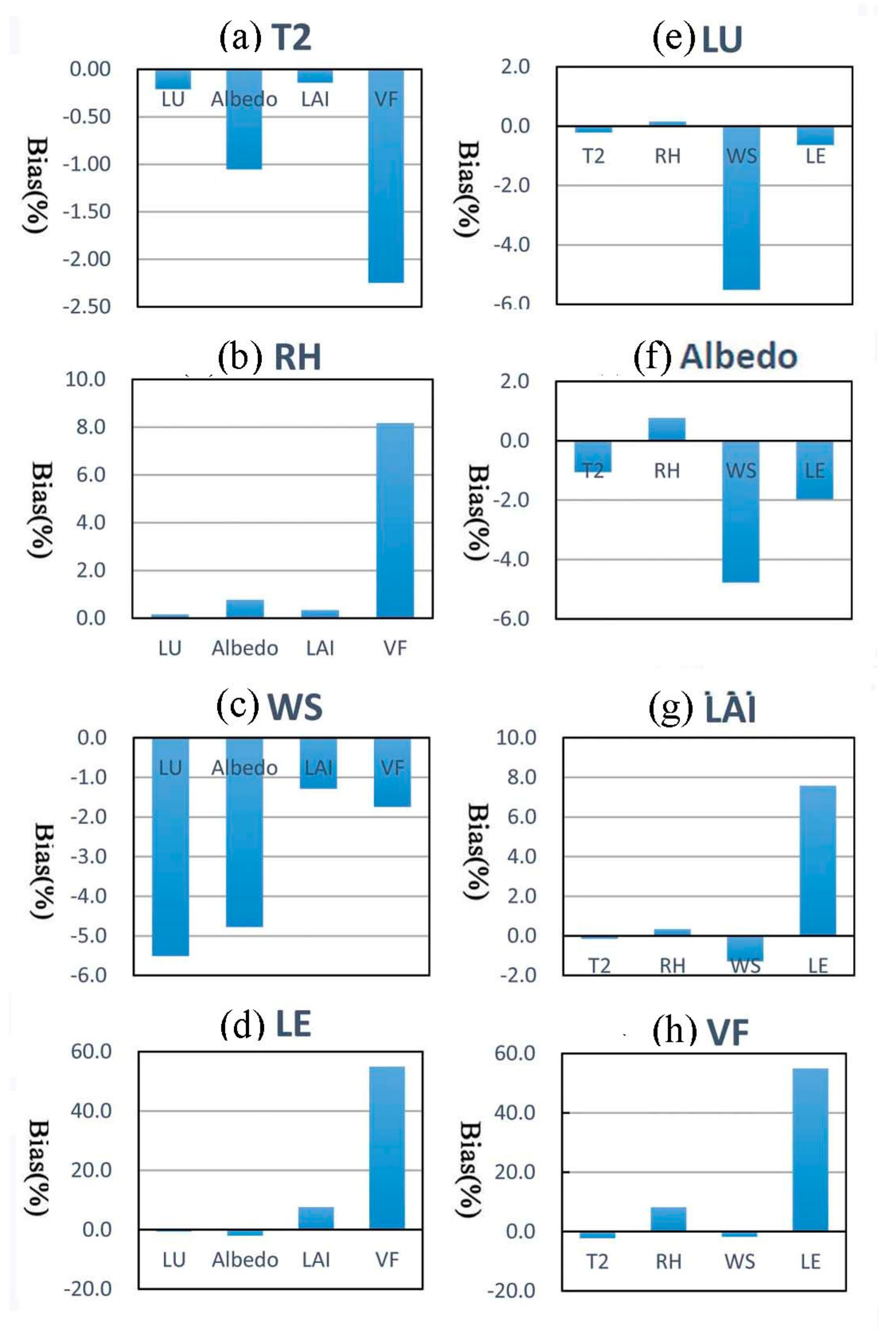
| ID | Longitude/°E | Latitude/°N | Altitude/m | LU | Measurements | Time |
|---|---|---|---|---|---|---|
| S1 | 86.20 | 44.32 | 473.10 | Crop/Urban | T2, P, RH, WS, WD | 2012 |
| S2 | 85.82 | 44.28 | 469.30 | Crop | T2, RH, SW, LW, LE | 2010, 2012 |
| S3 | 85.25 | 44.85 | 338.10 | Crop | T2, P, RH, WS, WD | 2012 |
| S4 | 86.10 | 45.02 | 347.80 | Crop | T2, P, RH, WS, WD | 2012 |
| S5 | 87.93 | 44.29 | 476 | Desert | T2, RH | 2010, 2012 |
| S6 | 87.92 | 44.48 | 448 | Desert | T2, RH, | 2010, 2012 |
| Land Use Type | Noah Soil Layer | Soil Moisture (cm3 cm−3) |
|---|---|---|
| Oasis | 0–10 cm | 0.38 (at 5 cm) |
| 10–40 cm | 0.47 (at 25 cm) | |
| 40–100 cm | 0.33 (at 70 cm) | |
| 100–200 cm | 0.26 (at 150 cm) | |
| Desert | 0–10 cm | 0.07 (at 5 cm) |
| 10–40 cm | 0.10 (at 25 cm) | |
| 40–100 cm | 0.05 (at 70 cm) | |
| 100–200 cm | 0.06 (at 150 cm) |
© 2017 by the authors. Licensee MDPI, Basel, Switzerland. This article is an open access article distributed under the terms and conditions of the Creative Commons Attribution (CC BY) license (http://creativecommons.org/licenses/by/4.0/).
Share and Cite
Zhang, M.; Luo, G.; De Maeyer, P.; Cai, P.; Kurban, A. Improved Atmospheric Modelling of the Oasis-Desert System in Central Asia Using WRF with Actual Satellite Products. Remote Sens. 2017, 9, 1273. https://doi.org/10.3390/rs9121273
Zhang M, Luo G, De Maeyer P, Cai P, Kurban A. Improved Atmospheric Modelling of the Oasis-Desert System in Central Asia Using WRF with Actual Satellite Products. Remote Sensing. 2017; 9(12):1273. https://doi.org/10.3390/rs9121273
Chicago/Turabian StyleZhang, Miao, Geping Luo, Philippe De Maeyer, Peng Cai, and Alishir Kurban. 2017. "Improved Atmospheric Modelling of the Oasis-Desert System in Central Asia Using WRF with Actual Satellite Products" Remote Sensing 9, no. 12: 1273. https://doi.org/10.3390/rs9121273





